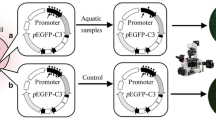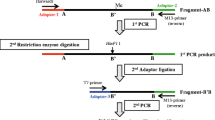Abstract
A variety of environmental pollutants may cause abnormal DNA methylation, which further disturb gene expression. In this work, we developed a rapid and sensitive method for the characterization and identification of the epigenotoxicity of environmental pollutants in terms of DNA methylation. The method combines in vitro inhibition reactions of a model DNA methyltransferase (DNMT) with rapid and sensitive capillary electrophoresis–laser-induced fluorescence (CE-LIF) immunoassays. This method was first assessed using two known DNMT inhibitors, (–)-epigallocatechin-3-gallate and RG108, and then applied to epigenotoxic evaluation of four aldehydes and six benzo-1,4-quinones. It was found that all these electrophilic chemicals could inhibit DNMT activity, probably due to their interactions with the active sites of DNMT. Interestingly, benzo-1,4-quinones displayed more inhibitory effects on DNMT activity than aldehydes. Among the tested six benzo-1,4-quinones, halogenated benzo-1,4-quinone showed higher inhibitory activity than non-halogenated p-benzo-1,4-quinone. Owing to its speed and sensitivity, our method will be potentially applicable for fast epigenotoxic screening of environmental pollutants and mechanistic study of environmental epigenetics.

Epigenotoxicity evaluation of environmental pollutants





Similar content being viewed by others
References
Jones PA, Takai D (2001) The role of DNA methylation in mammalian epigenetics. Science 293(5532):1068–1070
Singal R, Ginder GD (1999) DNA methylation. Blood 93(12):4059–4070
Kumar S, Cheng X, Klimasauskas S, Mi S, Posfai J, Roberts RJ, Wilson GG (1994) The DNA (cytosine-5) methyltransferases. Nucleic Acids Res 22(1):1–10
Ehrlich M (2002) DNA methylation in cancer: too much, but also too little. Oncogene 21(35):5400–5413
Kim YI, Giuliano A, Hatch KD, Schneider A, Nour MA, Dallal GE, Selhub J, Mason JB (1994) Global DNA hypomethylation increases progressively in cervical dysplasia and carcinoma. Cancer 74(3):893–899
Esteller M, Corn PG, Baylin SB, Herman JG (2001) A gene hypermethylation profile of human cancer. Cancer Res 61(8):3225–3229
Robertson KD (2005) DNA methylation and human disease. Nat Rev Genet 6(8):597–610
Momparler RL (2003) Cancer epigenetics. Oncogene 22(42):6479–6483
Anway MD, Cupp AS, Uzumcu M, Skinner MK (2005) Epigenetic transgenerational actions of endocrine disruptors and male fertility. Science 308(5727):1466–1469
Salnikow K, Zhitkovich A (2008) Genetic and epigenetic mechanisms in metal carcinogenesis and cocarcinogenesis: nickel, arsenic, and chromium. Chem Res Toxicol 21(1):28–44
Rusiecki JA, Baccarelli A, Bollati V, Tarantini L, Moore LE, Bonefeld-Jorgensen EC (2008) Global DNA hypomethylation is associated with high serum-persistent organic pollutants in Greenlandic Inuit. Environ Health Perspect 116(11):1547–1552
Jirtle RL, Skinner MK (2007) Environmental epigenomics and disease susceptibility. Nat Rev Genet 8(4):253–262
Bollati V, Baccarelli A (2010) Environmental epigenetics. Heredity (Edinb) 105(1):105–112
Weinhold B (2006) Epigenetics: the science of change. Environ Health Perspect 114(3):A160–167
De Rosa CT (2003) Restoring the foundation: tracking chemical exposures and human health. Environ Health Perspect 111(7):A374–375
McGeehin MA, Qualters JR, Niskar AS (2004) National environmental public health tracking program: bridging the information gap. Environ Health Perspect 112(14):1409–1413
Szyf M (2011) The implications of DNA methylation for toxicology: toward toxicomethylomics, the toxicology of DNA methylation. Toxicol Sci 120(2):235–255
Edwards TM, Myers JP (2007) Environmental exposures and gene regulation in disease etiology. Environ Health Perspect 115(9):1264–1270
Poirier LA, Vlasova TI (2002) The prospective role of abnormal methyl metabolism in cadmium toxicity. Environ Health Perspect 110(5):793–795
Friso S, Choi SW, Dolnikowski GG, Selhub J (2002) A method to assess genomic DNA methylation using high-performance liquid chromatography/electrospray ionization mass spectrometry. Anal Chem 74(17):4526–4531
Song L, James SR, Kazim L, Karpf AR (2005) Specific method for the determination of genomic DNA methylation by liquid chromatography–electrospray ionization tandem mass spectrometry. Anal Chem 77(2):504–510
Liu Z, Liu S, Xie Z, Blum W, Perrotti D, Paschka P, Klisovic R, Byrd J, Chan KK, Marcucci G (2007) Characterization of in vitro and in vivo hypomethylating effects of decitabine in acute myeloid leukemia by a rapid, specific and sensitive LC-MS/MS method. Nucleic Acids Res 35(5):e31
Wang XL, Song YL, Song MY, Wang ZX, Li T, Wang HL (2009) Fluorescence polarization combined capillary electrophoresis immunoassay for the sensitive detection of genomic DNA methylation. Anal Chem 81(19):7885–7891
Darii MV, Cherepanova NA, Subach OM, Kirsanova OV, Raskó T, Slaska-Kiss K, Kiss A, Deville-Bonne D, Reboud-Ravaux M, Gromova ES (2009) Mutational analysis of the CG recognizing DNA methyltransferase SssI: insight into enzyme–DNA interactions. Biochim Biophys Acta 1794(11):1654–1662
Bolton JL, Trush MA, Penning TM, Dryhurst G, Monks TJ (2000) Role of quinones in toxicology. Chem Res Toxicol 13(3):135–160
O'Brien PJ, Siraki AG, Shangari N (2005) Aldehyde sources, metabolism, molecular toxicity mechanisms, and possible effects on human health. Crit Rev Toxicol 35(7):609–662
Wang HL, Lu M, Tang MS, Van Houten B, Ross JB, Weinfeld M, Le XC (2009) DNA wrapping is required for DNA damage recognition in the Escherichia coli DNA nucleotide excision repair pathway. Proc Natl Acad Sci USA 106(31):12849–12854
Zhang DP, Lu ML, Wang HL (2011) Fluorescence anisotropy analysis for mapping aptamer–protein interaction at the single nucleotide level. J Am Chem Soc 133(24):9188–9191
Fang MZ, Wang Y, Ai N, Hou Z, Sun Y, Lu H, Welsh W, Yang CS (2003) Tea polyphenol (−)-epigallocatechin-3-gallate inhibits DNA methyltransferase and reactivates methylation-silenced genes in cancer cell lines. Cancer Res 63(22):7563–7570
Brueckner B, Garcia Boy R, Siedlecki P, Musch T, Kliem HC, Zielenkiewicz P, Suhai S, Wiessler M, Lyko F (2005) Epigenetic reactivation of tumor suppressor genes by a novel small-molecule inhibitor of human DNA methyltransferases. Cancer Res 65(14):6305–6311
Cogliano VJ, Grosse Y, Baan RA, Straif K, Secretan MB, El Ghissassi F, Working Group for Volume 88 (2005) Meeting report: summary of IARC monographs on formaldehyde, 2-butoxyethanol, and 1-tert-butoxy-2-propanol. Environ Health Perspect 113(9):1205–1208
Voulgaridou GP, Anestopoulos I, Franco R, Panayiotidis MI, Pappa A (2011) DNA damage induced by endogenous aldehydes: current state of knowledge. Mutat Res 711(1–2):13–27
Cai J, Bhatnagar A, Pierce WM Jr (2009) Protein modification by acrolein: formation and stability of cysteine adducts. Chem Res Toxicol 22(4):708–716
Wang HT, Hu Y, Tong D, Huang J, Gu L, Wu XR, Chung FL, Li GM, Tang MS (2012) Effect of carcinogenic acrolein on DNA repair and mutagenic susceptibility. J Biol Chem 287(15):12379–12386
Bestor TH (2000) The DNA methyltransferases of mammals. Hum Mol Genet 9(16):2395–2402
Tsai CH, Lin PH, Waidyanatha S, Rappaport SM (2001) Characterization of metabolic activation of pentachlorophenol to quinones and semiquinone in rodent liver. Chem Biol Interact 134(1):55–71
Qin F, Zhao YY, Zhao Y, Boyd JM, Zhou W, Li XF (2010) A toxic disinfection by-product, 2,6-dichloro-1,4-benzoquinone, identified in drinking water. Angew Chem Int Ed Engl 49(4):790–792
Zhao Y, Qin F, Boyd JM, Anichina J, Li XF (2010) Characterization and determination of chloro- and bromo-benzoquinones as new chlorination disinfection byproducts in drinking water. Anal Chem 82(11):4599–4605
Acknowledgments
The work was supported by the Grants from the National Basic Research Program of China (2009CB421605 and 2010CB933502) and the National Natural Science Foundation of China (21077129, 20877091, 20890112, 21125523, and 20921063) to Dr. H. Wang.
Author information
Authors and Affiliations
Corresponding author
Additional information
ABC Highlights: authored by Rising Stars and Top Experts.
Rights and permissions
About this article
Cite this article
Wang, X., Wang, H. Epigenotoxicity of environmental pollutants evaluated by a combination of DNA methylation inhibition and capillary electrophoresis–laser-induced fluorescence immunoassay. Anal Bioanal Chem 405, 2435–2442 (2013). https://doi.org/10.1007/s00216-013-6717-4
Received:
Revised:
Accepted:
Published:
Issue Date:
DOI: https://doi.org/10.1007/s00216-013-6717-4




